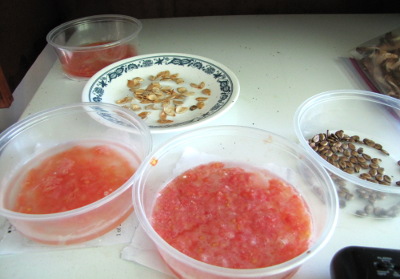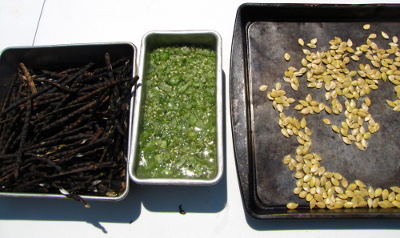
How many plants do I need to save vegetable seeds?
 As I slowly work my way
beyond the seed-saving
basics, I'm starting
to realize that saving the seeds from the lone kale plant that
overwintered in my garden might not be a good idea. To understand
how many individuals you need to save healthy seeds, first you have to
delve into a bit of pollination biology.
As I slowly work my way
beyond the seed-saving
basics, I'm starting
to realize that saving the seeds from the lone kale plant that
overwintered in my garden might not be a good idea. To understand
how many individuals you need to save healthy seeds, first you have to
delve into a bit of pollination biology.
All plants fit somewhere
on the spectrum between strong inbreeders and strong outbreeders.
At the far inbreeding extreme lie plants like
tomato-leaved tomatoes, peas, and green beans, all of which have
flowers that make it extremely unlikely that an insect can get inside
to move pollen from one plant to another. These vegetables breed
with themselves as a matter of course, so they've worked the bad
recessive traits out of their populations. The pros recommend
saving seeds from at least 20 plants for strong inbreeder species, but
at the backyard scale, you can get away with just a few parent plants
(or sometimes even one.)
 At
the opposite end of the spectrum, strong outbreeders (like most crucifers, swiss
chard, spinach, and beets) depend on getting pollen from another plant
to keep those recessive genes in check. You'll need around 80 to
100 individuals of these species in your garden to keep your seed
vigorous. If you save seeds from just a few individuals, next
year's plants will tend to be weaker and you'll eventually need to buy
seeds to reset your gene pool.
At
the opposite end of the spectrum, strong outbreeders (like most crucifers, swiss
chard, spinach, and beets) depend on getting pollen from another plant
to keep those recessive genes in check. You'll need around 80 to
100 individuals of these species in your garden to keep your seed
vigorous. If you save seeds from just a few individuals, next
year's plants will tend to be weaker and you'll eventually need to buy
seeds to reset your gene pool.
Most plants, of course,
lie somewhere in the middle, and there are also outbreeders (like most
cucurbits) that don't seem to show many problems even if you inbreed
them. You can download a free pdf
here that gives
recommended population sizes for most common vegetables. (The
website asks for your email address before download, but they haven't
sent me any spam. The file you want is A Seed
Saving Guide for Gardeners and Farmers.) Alternatively, if
you want to become a real seed-saving pro, I can't recommend Seed to Seed by Suzanne Ashworth highly
enough. This text made the very short list of book purchases in
our household for 2012 and has turned my dabbling in seed-saving into a
scientific endeavor.
Want more in-depth information? Browse through our books.
Or explore more posts by date or by subject.
About us: Anna Hess and Mark Hamilton spent over a decade living self-sufficiently in the mountains of Virginia before moving north to start over from scratch in the foothills of Ohio. They've experimented with permaculture, no-till gardening, trailersteading, home-based microbusinesses and much more, writing about their adventures in both blogs and books.
Want to be notified when new comments are posted on this page? Click on the RSS button after you add a comment to subscribe to the comment feed, or simply check the box beside "email replies to me" while writing your comment.

Hello Anna and Mark!
I commented somewhere on here a couple months ago - I think it was regarding your tranquility post. I've bought your e-books (need to post reviews) and look forward to every new blog post. I think I'm a Walden Effect addict.
Anyway, I mentioned that my husband (Justin) and I were looking at property that I thought might be near you - we closed on our land in Oscar Nichols Road in Kyles Ford, TN on July 20! It is 60 acres and has a creek, 2 springs, old barn, a couple sheds, and two cabins. We won't be moving to it for a few more years - we both have good jobs that we enjoy and are not quite ready to disembark from life here yet. But we are so incredibly excited to have made this major step in establishing our future homestead.
Justin visited the property back in May - my mother-in-law and I finally got to see it at the end of July. We were floored by the friendliness of the locals, scenic beauty of Appalachia, and personal freedom we felt while on our land. Justin and I going to try to get out there again sometime in October. Anyway, just wanted to give you a heads up that you have new (future) neighbors that are very much looking forward to applying your wisdom and know-how to our homesteading aspirations.
Cheers, Sarah Noce Boulder Creek, CA
Just followed your seed saving links to end up here and was able to download that resource from seedalliance. Thanks so much for that link.
And I second the recommendation of Seed to Seed. It's a great book. Now I just have to figure out how to do the seed saving thing well.